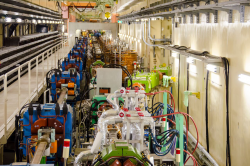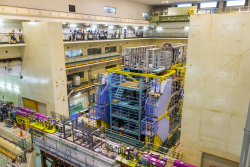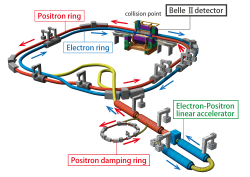

A new particle collider, SuperKEKB, located at the KEK laboratory in Tsukuba, Japan has achieved “First Turns” and is now in the test operation stage. This is the first new “atom-smasher” since the LHC, which is located at the CERN laboratory in Geneva, Switzerland. This futuristic machine was designed and built at KEK by a team of Japanese accelerator physicists.
The SuperKEKB collider, on which it is being installed the detector Belle II that also involves INFN Roma Tre (http://www.roma3.infn.it/ricerca/belle-ii/), aims to obtain the highest luminosity (a measure of the collision rate between particles) ever achieved by a particle accelerator.

On February 10, 2016, the SuperKEKB electron-positron collider succeeded in circulating and storing a positron beam moving close to the speed of light through over a thousand magnets in a narrow tube around the 3.0 kilometre circumference of its main ring.
On February 26, 2016, the SuperKEKB electron-positron collider succeeded in circulating and storing a seven billion electron-volt energy (7 GeV) electron beam around its ring of magnets in the opposite direction.
The achievement of “first turns”, which means storing the beam in the ring through many revolutions, is a major milestone for any new particle accelerator. In the case of SuperKEKB, the electron and positron beams have separate rings and different energies (7 GeV and 4 GeV, respectively). During full operation, the beams of electrons and positrons will collide and produce large numbers of new particles.
SuperKEKB, along with the Belle II detector at the interaction point, is a facility designed to search for New Physics beyond the Standard Model by measuring rare decays of elementary particles such as beauty quarks, charm quarks and tau leptons.
In contrast to the LHC at CERN, which is the world’s highest energy machine, SuperKEKB/Belle II at KEK in Tsukuba, Japan is designed to have the world’s highest luminosity or rate of collisions (a factor of 40 higher than the earlier KEKB machine that holds many of the current world records for accelerator performance). Thus, SuperKEKB will soon be the leading accelerator on the “luminosity frontier”.
The Belle II detector at SuperKEKB was designed and built by an international collaboration of over 600 students, scientists and engineers from 23 countries in Asia, Europe and North America. This collaboration is working closely with SuperKEKB accelerator experts to optimize the machine performance and backgrounds.
KEK press release: http://www.kek.jp/en/NewsRoom/Release/20160302163000/


